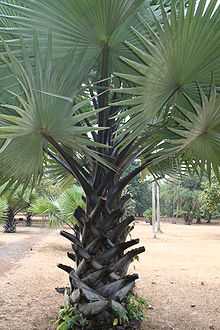Borassus aethiopum
| Borassus aethiopum | |
|---|---|
 | |
| Scientific classification | |
| Kingdom: | Plantae |
| (unranked): | Angiosperms |
| (unranked): | Monocots |
| (unranked): | Commelinids |
| Order: | Arecales |
| Family: | Arecaceae |
| Genus: | Borassus |
| Species: | B. aethiopum |
| Binomial name | |
| Borassus aethiopum Mart. | |
Borassus aethiopum is a species of Borassus palm from Africa. In English it is variously referred to as African fan palm, African palmyra palm, deleb palm, ron palm, toddy palm, black rhun palm, ronier palm (from the French) and other names. It is widespread across much of tropical and southern Africa from Senegal to Ethiopia to Zimbabwe, and also grows in Madagascar and the Comoros.[1][2]
Description
Borassus aethiopum grows swelling, solitary trunks to 25 metres (82 ft) in height and 1 metre (3 ft 3 in) in diameter at the base. The green leaves — 3 metres (9.8 ft) wide — are carried on petioles — 2 metres (6 ft 7 in) long — which are armed with spines. The crownshaft is spherical to 7 metres (23 ft) wide, the leaves are round with stiff leaflets, segmented a third or half-way to the petiole. In male plants the flower is small and inconspicuous; females grow larger, 2 centimetres (0.79 in) flowers which produce yellow to brown fruit resembling the coconut containing up to 3 seeds.[3]
Uses
The tree has many uses: the fruit are edible, as are the tender roots produced by the young plant;[4] fibres can be obtained from the leaves; and the wood (which is reputed to be termite-proof) can be used in construction.[5]
See also
- Great Mosque of Djenné (example of use of wood in construction)
References
- ↑ Kew World Checklist of Selected Plant Families, Borassus aethiopum
- ↑ AFPD. 2008. African Flowering Plants Database - Base de Donnees des Plantes a Fleurs D'Afrique.
- ↑ Martius, Carl Friedrich Philipp von. 1838. Historia Naturalis Palmarum 3(7): 220–221, Borassus aethiopum
- ↑
 "Deleb palm". Collier's New Encyclopedia. 1921.
"Deleb palm". Collier's New Encyclopedia. 1921. - ↑ Bailey, L.H. & E.Z. Bailey. 1976. Hortus Third i–xiv, 1–1290. MacMillan, New York.
External links
| Wikimedia Commons has media related to Borassus aethiopum. |
- Horticopia page on B. aethiopium
- PACSOF page on B. aethiopium
- La Plant Encyclo page on B. aethiopum (in French)
- Multilingual Multiscript Plant Name Database page on Borassus
- Borassus aethiopum in West African plants – A Photo Guide.
- "Borassus aethiopum". Ecocrop FAO. Retrieved 2010-02-08.